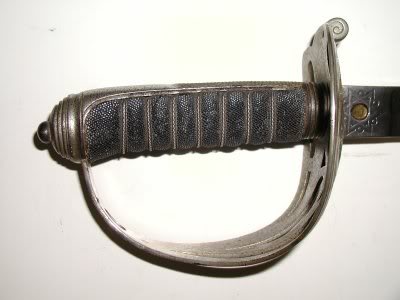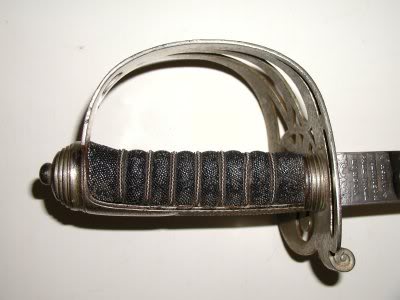Illustrated below is a Pattern 1854 Guards Officer's Sword is by Wilkinson, and is for the Scots Guards. It has a nickel-plated steel guard and scabbard, fishskin grip with silver twist wire wrap, and a well-etched blade that includes the numerous battle honours earned by the regiment. Blade: 32 ½ Overall: 38 Ύ Weight: 1 lb. 14 oz.
The serial number is 35802, and is recorded in the sales ledger as follows:
Scots Guards Sword, nickel plated hilt and scabbard.
Made/completed on 13 May 1898.
Sold to Honourable Walter Trefusis of the Scots Guards.
Overall:

The Honourable Walter Alexander Hepburn-Stewart-Forbes-Trefusis, b. 1879, d. 1926, was the 4th son of 20th Baron Clinton. His family had quite a legacy in the Scots Guards, and he and his brothers carried on this tradition. Trefusis was educated at Eton (January 1893- July 1897) and the Royal Military College at Sandhurst. He was commissioned in the Scots Guards in either 1897 or 1898, the latter date seeming likely since this is when he purchased his sword (perhaps he was at Sandhurst between July, 1897 and May, 1898?).
According the London Times Boer War Shipping Lists, Trefusis embarked for South Africa on 15 March, 1900 aboard the Britannic, and returned home aboard the Saxon on 12 December, 1900. Upon embarking he is listed as a Second Lieutenant, and upon returning he is listed as a Lieutenant.
In 1911, Trefusis married Marjorie Winifred, the second daughter of Sir Henry John Lowndes Graham, KCB. Trefusis divorced Marjorie Winifred in 1919 and appears not to have remarried.
At some point between the end of the Boer War and the beginning of World War I, Trefusis attained the rank of captain in the Scots Guards.
Dod's Peerage for 1916 shows Trefusis as a Major in the "R[oyal] N[aval] D[ivision], late Scots Guards". According to the London Gazette for 10 November, 1914, Trefusis received a temporary commission as a major in the Royal Marines forces, and the medal rolls (which are quite difficult to read) list him as a major in the Scots Guards and in the Naval Forces. He is mentioned in Jerrold's history of the RND as being 2nd in command of the 4th (Collingwood) Battalion. The Royal Naval Division is known for its participation in many important battles in the First World War, Gallipoli being one of the most well-known.
I chanced across a thread on the Great War Forums in which Trefusis is quoted:
| Quote: |
| Major Walter Trefusis, Collingwood Battalion, writing from Groningen on Dec 5th. 1914
To OC 1st Brigade, RND; Item C. Want of proper Equipment 1 Greatcoats; though the majority of the men got them at Dunkerque 2 Haversacks, mess tins & water-bottles; so that the men had nowhere to carry food, drink, or spare kit 3 Entrenching tools 4 First Aid bandages 5 Iron rations 6 Web equipment and rifle slings I think that the natural fatigue of the men was much increased by want of some of the above articles. Perhaps I may be permitted to remark here that although the sending of untrained troops to Antwerp may have been fully justified by the military situation, it does not seem easy to justify the sending of badly equipped troops. [quoted from RND No.16, Mar 2001] http://1914-1918.invisionzone.com/forums/lofi...25587.html |
The Honourable Walter Alexander Trefusis reached the rank of Lieutenant-Colonel by the time he retired from the Army. Having survived the Boer War and World War I, Trefusis died in 1926 at age 47.
As you can see, there are some rather significant gaps in my knowledge regarding Trefusis' service. I have mailed a query to the regiment to request any additional information they might have on Col. Trefusis' service.
Hilt:

Hilt detail:

Blade details:












